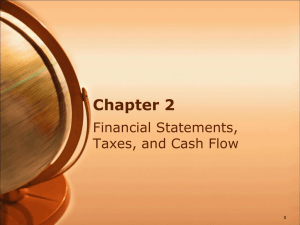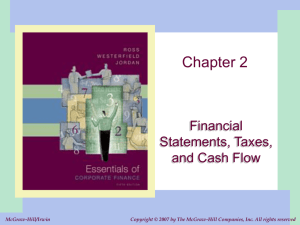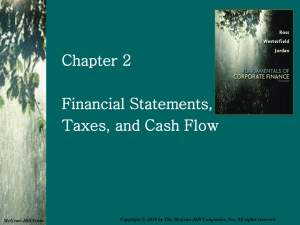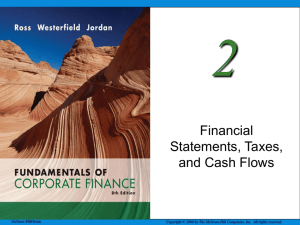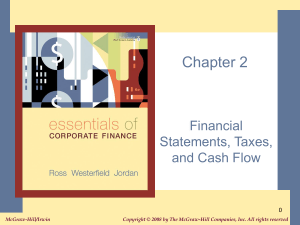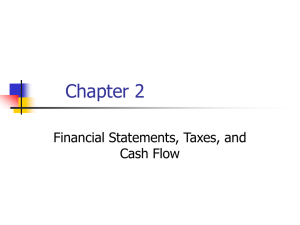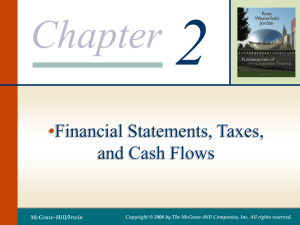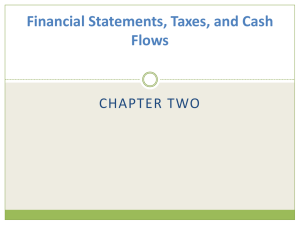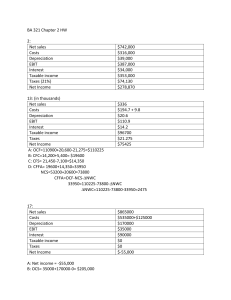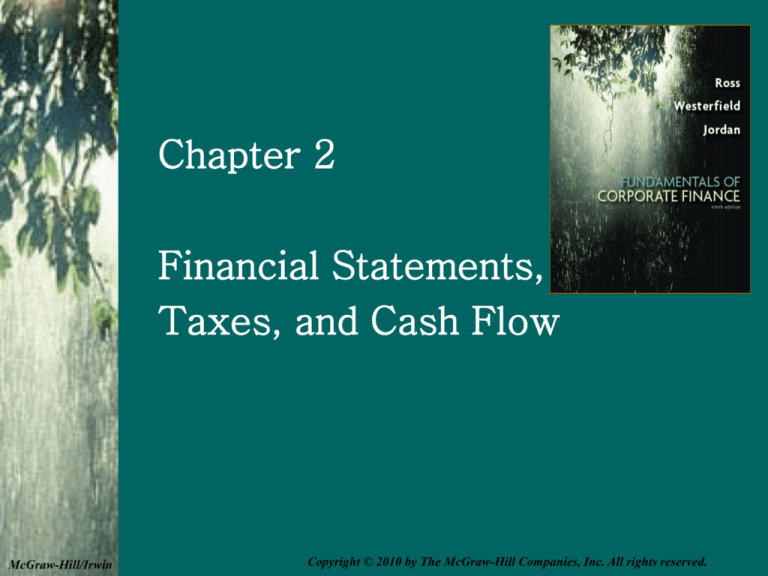
Chapter 2
Financial Statements,
Taxes, and Cash Flow
McGraw-Hill/Irwin
Copyright © 2010 by The McGraw-Hill Companies, Inc. All rights reserved.
Key Concepts and Skills
• Know the difference between book
value and market value
• Know the difference between
accounting income and cash flow
• Know the difference between
average and marginal tax rates
• Know how to determine a firm’s cash
flow from its financial statements
2-1
Chapter Outline
•
•
•
•
The Balance Sheet
The Income Statement
Taxes
Cash Flow
2-2
Balance Sheet
• The balance sheet is a snapshot of the
firm’s assets and liabilities at a given point
in time
• Assets are listed in order of decreasing
liquidity
– Ease of conversion to cash
– Without significant loss of value
• Balance Sheet Identity
– Assets = Liabilities + Stockholders’ Equity
2-3
The Balance Sheet - Figure
2.1
2-4
Net Working Capital and
Liquidity
• Net Working Capital
– = Current Assets – Current Liabilities
– Positive when the cash that will be received over the next 12
months exceeds the cash that will be paid out
– Usually positive in a healthy firm
• Liquidity
– Ability to convert to cash quickly without a significant loss in
value
– Liquid firms are less likely to experience financial distress
– But liquid assets typically earn a lower return
– Trade-off to find balance between liquid and illiquid assets
2-5
US Corporation Balance Sheet
– Table 2.1
Place Table 2.1 (US Corp Balance Sheet)
here
2-6
Market Value vs.
Book Value
• The balance sheet provides the book
value of the assets, liabilities, and equity.
• Market value is the price at which the
assets, liabilities ,or equity can actually be
bought or sold.
• Market value and book value are often
very different. Why?
• Which is more important to the decisionmaking process?
2-7
Example 2.2 Klingon
Corporation
KLINGON CORPORATION
Balance Sheets
Market Value versus Book Value
Book
Market
Assets
NWC
NFA
$ 400
700
1,100
Book
Market
Liabilities and
Shareholders’ Equity
$ 600 LTD
1,000 SE
1,600
$ 500
$ 500
600
1,100
1,100
1,600
2-8
Income Statement
• The income statement is more like a
video of the firm’s operations for a
specified period of time.
• You generally report revenues first and
then deduct any expenses for the period
• Matching principle – GAAP says to show
revenue when it accrues and match the
expenses required to generate the
revenue
2-9
US Corporation Income
Statement – Table 2.2
Insert new Table 2.2 here (US Corp Income
Statement)
2-10
Work the Web Example
• Publicly traded companies must file
regular reports with the Securities and
Exchange Commission
• These reports are usually filed
electronically and can be searched at the
SEC public site called EDGAR
• Click on the web surfer, pick a company,
and see what you can find!
2-11
Taxes
• The one thing we can rely on with taxes is
that they are always changing
• Marginal vs. average tax rates
– Marginal tax rate – the percentage paid on
the next dollar earned
– Average tax rate – the tax bill / taxable
income
• Other taxes
2-12
Example: Marginal Vs.
Average Rates
• Suppose your firm earns $4 million in
taxable income.
– What is the firm’s tax liability?
– What is the average tax rate?
– What is the marginal tax rate?
• If you are considering a project that will
increase the firm’s taxable income by $1
million, what tax rate should you use in
your analysis?
2-13
The Concept of Cash Flow
• Cash flow is one of the most important
pieces of information that a financial
manager can derive from financial
statements
• The statement of cash flows does not
provide us with the same information that
we are looking at here
• We will look at how cash is generated
from utilizing assets and how it is paid to
those that finance the purchase of the
assets
2-14
Cash Flow From Assets
• Cash Flow From Assets (CFFA) =
Cash Flow to Creditors + Cash Flow
to Stockholders
• Cash Flow From Assets = Operating
Cash Flow – Net Capital Spending –
Changes in NWC
2-15
Example: US Corporation –
Part I
• OCF (I/S) = EBIT + depreciation – taxes =
$547
• NCS ( B/S and I/S) = ending net fixed
assets – beginning net fixed assets +
depreciation = $130
• Changes in NWC (B/S) = ending NWC –
beginning NWC = $330
• CFFA = 547 – 130 – 330 = $87
2-16
Example: US Corporation –
Part II
• CF to Creditors (B/S and I/S) = interest
paid – net new borrowing = $24
• CF to Stockholders (B/S and I/S) =
dividends paid – net new equity raised
= $63
• CFFA = 24 + 63 = $87
2-17
Cash Flow Summary Table 2.5
2-18
Example: Balance Sheet and
Income Statement Information
• Current Accounts
– 2009: CA = 3625; CL = 1787
– 2008: CA = 3596; CL = 2140
• Fixed Assets and Depreciation
– 2009: NFA = 2194; 2008: NFA = 2261
– Depreciation Expense = 500
• Long-term Debt and Equity
– 2009: LTD = 538; Common stock & APIC = 462
– 2008: LTD = 581; Common stock & APIC = 372
• Income Statement
– EBIT = 1014; Taxes = 368
– Interest Expense = 93; Dividends = 285
2-19
Example: Cash Flows
• OCF = 1,014 + 500 – 368 = 1,146
• NCS = 2,194 – 2,261 + 500 = 433
• Changes in NWC = (3,625 – 1,787) – (3,596 –
2,140) = 382
• CFFA = 1,146 – 433 – 382 = 331
• CF to Creditors = 93 – (538 – 581) = 136
• CF to Stockholders = 285 – (462 – 372) = 195
• CFFA = 136 + 195 = 331
• The CF identity holds.
2-20
Ethics Issues
• Why is manipulation of financial
statements not only unethical and illegal,
but also bad for stockholders?
2-21
End of Chapter
2-22

